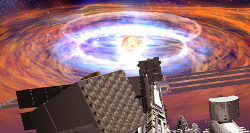 HEAPOW: Finding Our Way through the Outer Dark (2018 Jan 22)
HEAPOW: Finding Our Way through the Outer Dark (2018 Jan 22)
Guiding ships through the outer solar system or beyond is a difficult endeavour. Determining positions and course-corrections from earth becomes increasingly difficult, given the light-travel time to distant spacecraft. For example, it can take more than a day and a half for a command from earth, traveling at the speed of light, to reach the Voyager 1 spacecraft and for earth to get a response. But nature provides "cosmic lighthouses" to help the wandering spacecraft to find its way. These lighthouses are X-ray pulsars - rapidly spinning neutron stars which produce periodic flashes of light as the star rotates. X-ray pulsars are distributed throughout the Milky Way (and other galaxies too). Recently the NICER/SEXTANT instrument (shown in the foreground of the image above), which is currently berthed on the International Space Station, conducted a test to determine the location of the ISS using pulsar navigation. NICER/SEXTANT's main science goal is to make high-precision studies of the periodic X-ray flashes of X-ray pulsars, and use those observations to determine what mysterious stuff lies beneath the pulsar's surface. But, as its alter-ego SEXTANT (Station Explorer for X-ray Timing and Navigation Technology ), the instrument can use the timing of X-ray pulsars to measure observed slight shifts in the pulse period, produced by the motion of ISS as it orbits earth. Over a day and a half in November, NICER/SEXTANT measured the X-ray pulse periods of five X-ray pulsars. By analyzing these data, the position of the ISS could be calculated to better than 5 kilometers. This demonstration shows that, indeed, these "cosmic lighthouses" serve as nature's GPS: the Galactic Positioning System.
Nature: NASA test proves pulsars can function as a celestial GPS
GSFC: NASA Team First to Demonstrate X-ray Navigation in Space
Characterization of Pulsar Sources for X-ray Navigation - Paul S. Ray, Kent S. Wood, Michael T. Wolff
- arXiv.org > astro-ph > arXiv:1711.08507 > 22 Nov 2017
| << Previous HEAPOW | High Energy Astrophysics Picture of the Week | Next HEAPOW >> |